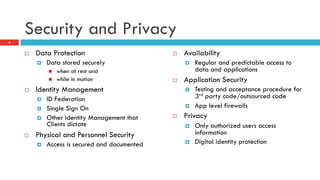Cloud computing Security
- 3. Cloud Security Issues/Concerns ¨ Faced by providers ¤ Ensure that infrastructure is secure ¤ Client data and apps are protected ¨ Faced by clients ¤ Ensure that provider has taken proper measures to protect info 3 Security and Privacy Compliance Legal/ Contractual issues
- 4. Security and Privacy ¨ Data Protection ¤ Data stored securely n when at rest and n while in motion ¨ Identity Management ¤ ID Federation ¤ Single Sign On ¤ Other Identity Management that Clients dictate ¨ Physical and Personnel Security ¤ Access is secured and documented ¨ Availability ¤ Regular and predictable access to data and applications ¨ Application Security ¤ Testing and acceptance procedure for 3rd party code/outsourced code ¤ App level firewalls ¨ Privacy ¤ Only authorized users access information ¤ Digital identity protection 4
- 5. Compliance Cloud providers must enable clients to comply with regulations ¨ Laws and Regulations ¤ Depends on geography and laws of the land ¤ e.g., Health Insurance Portability and Accountability Act (HIPAA), Sarbanes- Oxley Act (SarbOx) ¨ Industry Standards ¤ e.g., Payment Card Industry Data Security Standard (PCI DSS) ¨ Regular reporting requirements ¨ Audit Trails ¨ Business Continuity and Data Recovery ¤ Services continue even in case of a disaster ¤ Plan for recovery of lost data ¨ Logs and Audit Trails ¤ eDiscovery ¤ Forensic Investigation ¨ Client specific compliance requirements ¨ Data isolation requirements 5
- 6. Legal/Contractual Issues ¨ Liability Terms ¨ Intellectual Property ¨ End of service obligations ¨ Public records ¤ Record keeping ¤ Retain and make data available ¤ May be stipulated by law 6
- 7. Computer Security 7 Secure OS Secure Architecture Security by design Secure coding practise Vulnerability Eavesdropping Exploits Trojans/Virus/DOS Payloads Backdoors/Rootkits/Key loggers ComputerSecurity ComputerInsecurity
- 8. Security by Design 8 ¨ Principle of least privilege ¤ An entity has only the privileges it needs to function ¤ Hacker gaining access to one part would find it equally difficult to access other parts ¨ Breaking modules into small individual components simplifies correct design of crucial software subsystems ¨ Rigorous code review and unit testing ¨ Smart Secure Default Settings ¤ Fail to a secure state. Not fail to an insecure state ¤ A secure system should require deliberate, conscious, knowledgeable and free decision on part of legitimate authority in order to make it insecure
- 9. Security Architecture ¨ Design artifacts that describe how security controls are positioned to ensure system quality attributes 9 Confidentiality Integrity AvailabilityAccountability Assurance
- 10. Hardware Mechanisms for Security 10 ¨ Hardware based or hardware assisted compliments software based security, e.g, ¤ Trusted Platform Modules (TPM) ¤ Devices/Dongles that require physical access
- 11. Secure OS 11 ¨ Ultra-strong secure OS ¤ Based on kernel that guarantee certain security policies are absolutely enforced in an operating environment ¤ e.g., Bell-LaPadula model ¤ Such OS are not widely known ¤ Used primarily to protect n National security/Military secrets ¤ e.g., NSA Blacker, Honeywell SCOMP ¤ Achieve the orange book standard Microprocessor Hardware Features such as memory management Correctly implemented OS kernel
- 12. Secure Coding 12 ¨ Most commercial OS fall in a “low security” category so applications must make themselves resistant to malicious subversion ¨ Common software defects include ¤ buffer overflows ¤ format string vulnerabilities ¤ integer overflow ¤ code/command injection ¤ dangling pointers
- 13. Application Threats/Attacks ¨ Input Validation ¤ Buffer overflow, cross site scripting, SQL injection ¨ Authentication ¤ Eavesdropping, brute force attack, dictionary attach, cookie replay, credential theft ¨ Authorization ¤ Elevation of privilege, disclosure of confidential info, data tampering ¨ Configuration Management ¤ Unauth access to admin interfaces, retrieval of config data in clear text, lack of individual accountability ¨ Sensitive Information ¤ Unauth access to stored data ¨ Session Management ¤ Session hijacking, session replace, man in the middle attacks ¨ Cryptography ¤ Poor key generation, weak encryption, improper key management practices ¨ Parameter Manipulation ¤ Query string manipulation, Form field manipulation, cookie manipulation, HTTP header manipulation ¨ Exception management ¤ Improper info disclosure, denial of service ¨ Auditing and logging ¤ User denies performing an operation, attacker exploits without a trace or covers the tracks 13
- 14. Questions and discussion on topic 14
- 15. 15 Thank you.















